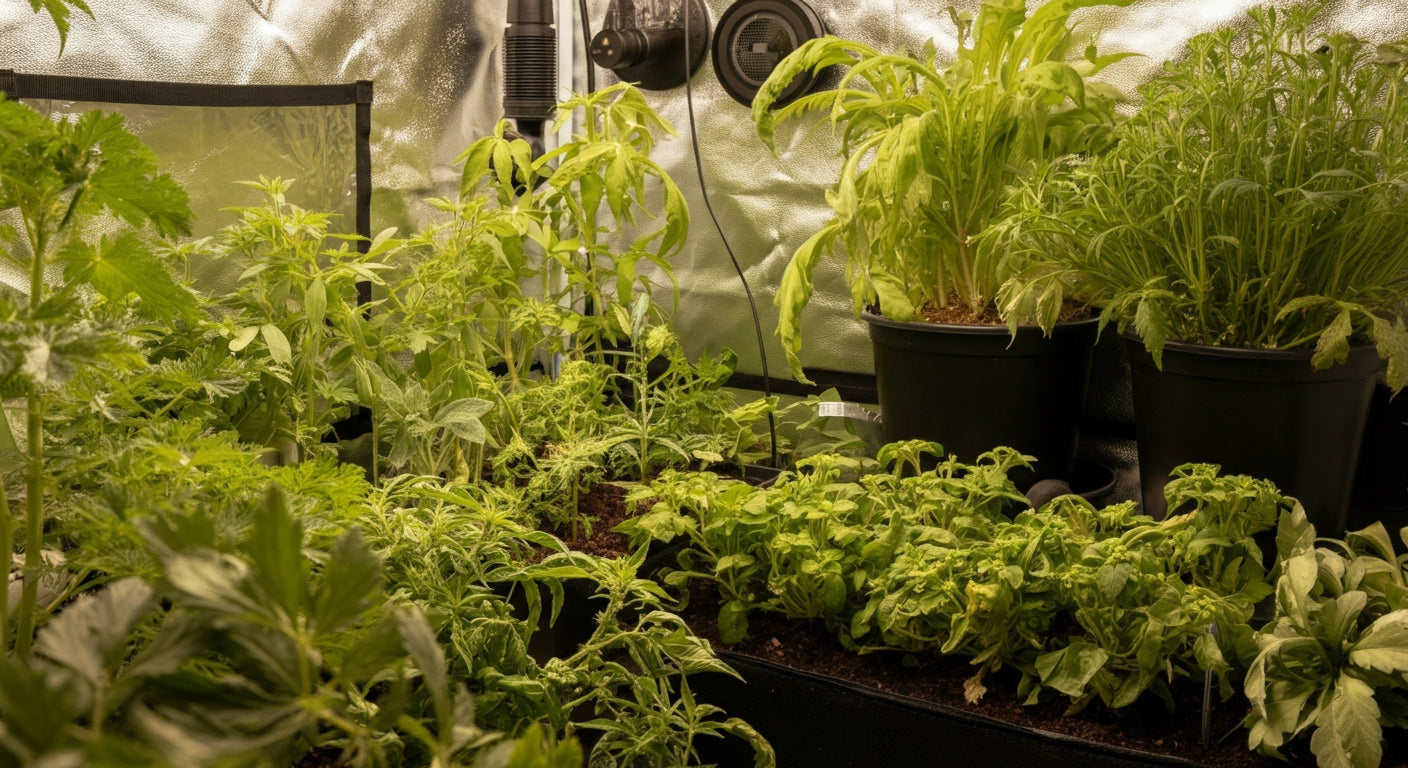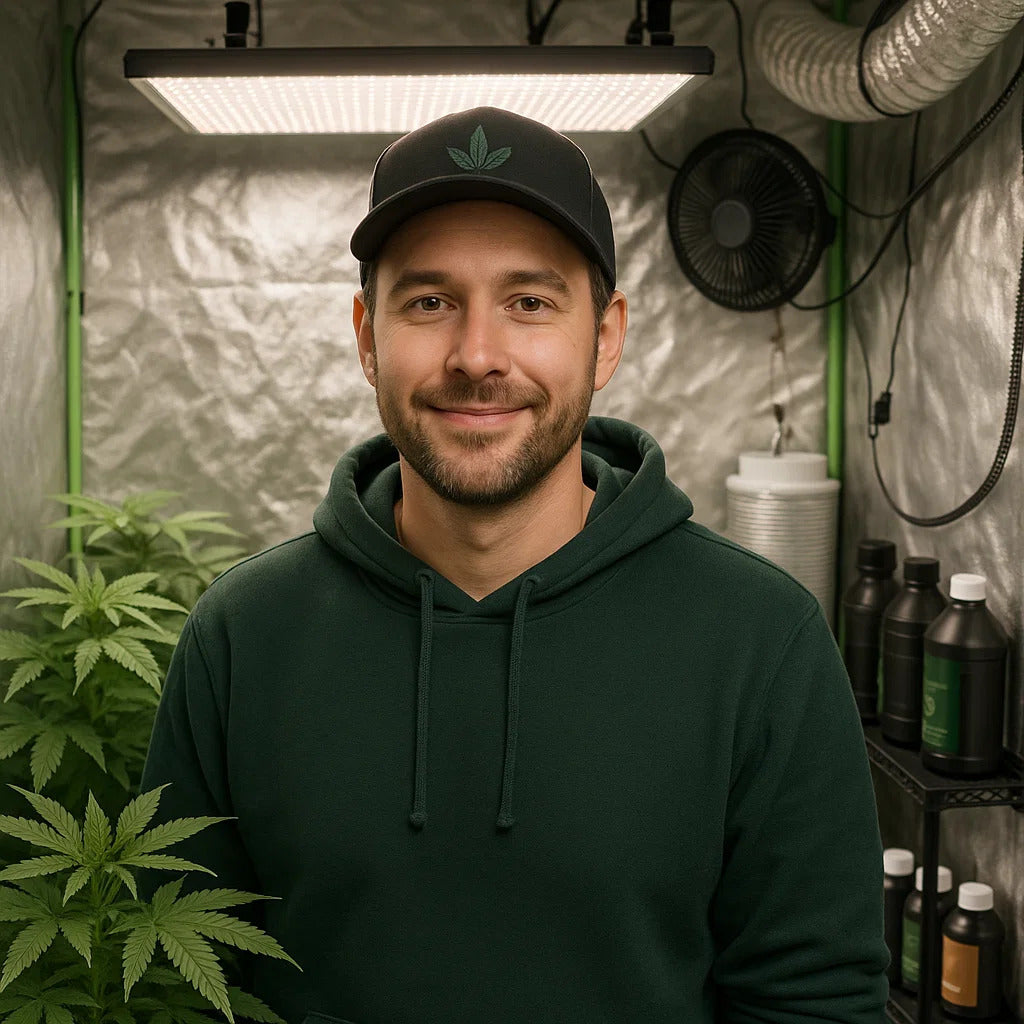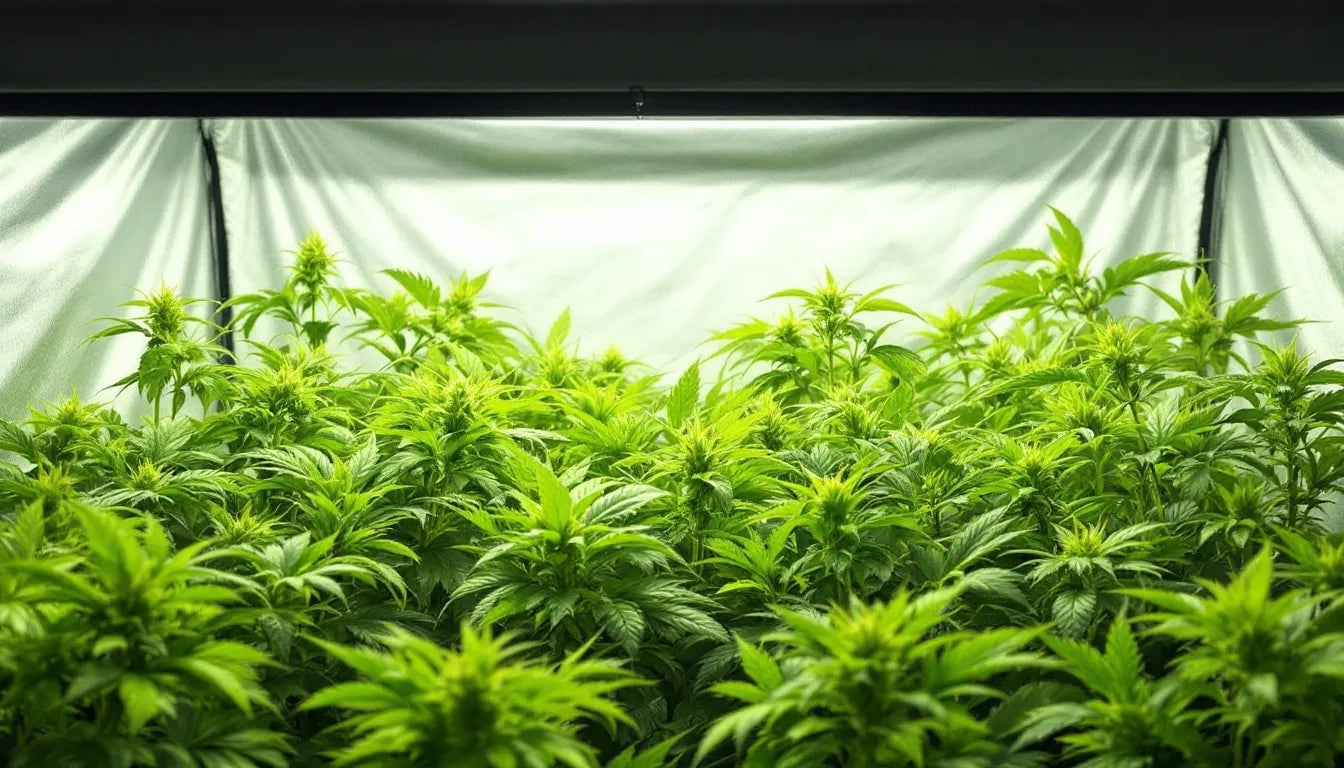
How to Add CO2 to Grow Tent: Ultimate Guide for Maximum Plant Growth
Are your plants growing slower than expected despite providing optimal light, nutrients, and water? The missing element might be carbon dioxide (CO2). Adding CO2 to your grow tent can supercharge photosynthesis, leading to faster growth rates, bigger yields, and healthier plants. In this comprehensive guide, we'll walk you through everything you need to know about CO2 supplementation, from the basics to advanced techniques.
Understanding Why CO2 Is Critical for Plant Growth
Carbon dioxide is one of the fundamental building blocks of plant life. During photosynthesis, plants convert light energy, water, and CO2 into glucose (energy) and oxygen. This glucose powers all plant growth and development.
The Science Behind CO2 and Photosynthesis
In simplest terms, the photosynthesis equation looks like this:
CO2 + H2O + Light Energy → Glucose (C6H12O6) + Oxygen (O2)
Without sufficient CO2, this process becomes limited—no matter how perfect your other growing conditions might be. In a natural outdoor environment, CO2 levels hover around 400 parts per million (ppm). However, research has shown that most plants can utilize CO2 at much higher concentrations—up to 1,200-1,500 ppm—resulting in dramatically accelerated growth.
The Benefits of CO2 Supplementation in Grow Tents
Adding CO2 to your grow tent can provide numerous advantages:
- Accelerated Growth: Plants can grow up to 20-30% faster with optimal CO2 levels
- Increased Yields: Higher CO2 concentrations can boost harvest volume significantly
- Better Heat Tolerance: Plants can thrive at higher temperatures with elevated CO2
- Improved Nutrient Efficiency: Enhanced metabolism leads to better nutrient utilization
- Shortened Growing Cycles: Faster growth means quicker time to harvest

Optimal CO2 Levels for Different Growth Stages
Different growth stages benefit from varying CO2 concentrations:
| Growth Stage | Optimal CO2 Range (ppm) | Notes |
|---|---|---|
| Seedling/Clone | 400-600 | Young plants need less CO2 |
| Vegetative | 800-1,200 | Rapid growth phase benefits from higher CO2 |
| Early Flowering | 1,000-1,300 | Critical period for size development |
| Late Flowering | 1,200-1,500 | Maximum CO2 for final yield boost |
It's important to note that increasing CO2 without other environmental factors optimized will yield minimal benefits. For CO2 to be fully effective, you'll need:
- Strong lighting (minimum 600 PPFD)
- Proper temperature (75-85°F/24-29°C)
- Adequate nutrients
- Proper humidity (40-70% depending on growth stage)
5 Effective Methods to Add CO2 to Your Grow Tent
There are several ways to supplement CO2 in your grow tent, each with its own advantages and considerations. Let's explore the most popular options:
1. CO2 Bags and Mushroom-Based Systems
CO2 bags utilize fungi (mycelium) that naturally produce CO2 as they consume organic material within the bag. This method is perfect for beginners and smaller grow tents.
Pros:
- Affordable entry point for CO2 supplementation
- No mechanical parts or risk of malfunction
- Completely natural and organic process
- No heat generation
- Simple to implement—just hang and forget
Cons:
- Limited control over CO2 output
- Generally provides lower CO2 concentrations
- Needs replacement every 4-6 months
- Less effective in larger spaces
Implementation Tips:
- Hang bags slightly above plant canopy (CO2 is heavier than air)
- Use one bag per 4x4 ft area (or per 4-6 plants)
- Position bags near air circulation but away from direct outgoing ventilation
- Activate according to manufacturer instructions
- Replace when white mycelium growth stops
2. Compressed CO2 Tanks with Regulators
A CO2 tank and regulator system is the most precise method for CO2 enrichment, allowing for exact control over CO2 delivery.
Pros:
- Precise control over CO2 levels
- Can achieve and maintain specific ppm targets
- Reliable and consistent output
- Works in any size grow space
- Long-lasting with minimal maintenance
Cons:
- Higher initial investment
- Requires periodic tank refills
- Takes up space inside or outside the tent
- Needs proper setup and safety precautions
Implementation Tips:
- Place the tank outside your grow tent for space efficiency
- Install distribution tubing around the upper perimeter of your tent
- Connect the regulator to a timer or CO2 controller for automation
- Ensure proper sealing of your tent to prevent CO2 waste
- Keep tanks secured in an upright position to prevent tipping
3. CO2 Generators
CO2 generators produce carbon dioxide by burning propane or natural gas. These are typically used in larger grow operations or commercial settings.
Pros:
- Produces high volumes of CO2
- Cost-effective for larger spaces
- No need for tank refills
- Can maintain high ppm levels consistently
Cons:
- Generates heat (can raise grow room temperature)
- Produces moisture (can increase humidity)
- Potential fire hazard if not properly installed
- Requires proper ventilation and safety measures
- Not recommended for small grow tents
Implementation Tips:
- Only use in well-ventilated, larger grow spaces
- Install proper safety equipment (CO detector, fire extinguisher)
- Ensure proper gas line installation
- Use with environmental controllers to manage heat output
- Never use in small, enclosed spaces without proper safety measures
4. Fermentation Methods (DIY Solutions)
Fermentation using yeast, sugar, and water can produce CO2 inexpensively. This DIY approach is popular among growers on a budget.
Pros:
- Very low cost
- Easy to implement with household materials
- No special equipment needed
- Completely natural process
Cons:
- Unpredictable and inconsistent output
- Requires frequent maintenance and solution changes
- Limited CO2 production capability
- Can create mess if bottles tip over
Implementation Tips:
- Use a 2-liter plastic bottle with warm water, sugar, and yeast
- Create a sealed system with tubing for CO2 delivery
- Place multiple bottles around larger grow spaces
- Replace solution every 2-3 weeks
- Keep temperatures consistent for reliable fermentation
5. Vinegar and Baking Soda Reaction
The chemical reaction between vinegar and baking soda produces CO2 and can be used as a temporary or emergency solution.
Pros:
- Extremely low cost
- Easily available materials
- Quick to implement
- No special equipment needed
Cons:
- Very short duration of CO2 production
- Requires constant replenishment
- Difficult to control or measure output
- Labor-intensive to maintain
Implementation Tips:
- Use an automated drip system for longer-lasting effects
- Set up multiple reaction containers for larger spaces
- Monitor pH to ensure reaction continuity
- Replace solutions frequently
Setting Up Your Grow Tent for Optimal CO2 Use
Proper setup is crucial for effective CO2 supplementation. Here's how to prepare your grow space:
Creating a Sealed Environment
CO2 supplementation works best in a sealed environment to prevent wasteful loss of the gas:
- Seal all leaks: Check for and seal any gaps or holes in your grow tent
- Minimize air exchange: Reduce exhaust fan operation during CO2 enrichment
- Use negative pressure: If ventilation is necessary, maintain slight negative pressure
- Implement a closed-loop system: Recirculate air rather than exhausting it when possible
- Consider automated controls: Use timers or controllers to manage ventilation cycles
Optimizing Airflow for CO2 Distribution
Since CO2 is heavier than air, proper circulation is essential:
- Install oscillating fans: Position them to create gentle air movement throughout the tent
- Direct airflow horizontally: Avoid blowing directly on plants or creating dead spots
- Position CO2 delivery points strategically: Place them above the canopy to allow gas to fall naturally
- Avoid excessive turbulence: Too much air movement can push CO2 out of the grow space
- Create a circulating pattern: Air should move in a circular pattern around the tent
CO2 Timing and Automation
To maximize efficiency, only provide CO2 when plants can utilize it:
- Daytime enrichment only: Only supplement during light hours when photosynthesis occurs
- Start 30 minutes after lights on: Allow plants to "wake up" before adding CO2
- Stop 30 minutes before lights off: Avoid wasting CO2 when plants are shutting down
- Consider growth stage: Adjust enrichment schedule based on plant development
- Coordinate with ventilation: Time CO2 release to occur when ventilation is minimal
Monitoring and Measuring CO2 Levels
Proper monitoring is essential for successful CO2 supplementation:
CO2 Monitoring Equipment
Several tools can help you track CO2 levels:
- Handheld CO2 meters: Portable devices for spot-checking CO2 levels
- Wall-mounted CO2 monitors: Provide continuous readings of ambient CO2
- CO2 controllers: Automatically maintain set CO2 levels by controlling equipment
- Data loggers: Track CO2 trends over time for optimization
- Smart monitors: Connect to apps or systems for remote monitoring
Calibration and Maintenance
To ensure accuracy:
- Calibrate regularly: Follow manufacturer recommendations for calibration
- Keep sensors clean: Dust and humidity can affect readings
- Replace sensors as needed: Most CO2 sensors have a limited lifespan
- Check batteries: Ensure power supply is consistent
- Compare readings: Use multiple measurement points to verify accuracy
Advanced CO2 Strategies for Experienced Growers
Once you've mastered the basics, consider these advanced techniques:
CO2 Enrichment with Light Intensity Correlation
For maximum efficiency, CO2 levels should be correlated with light intensity:
- Higher light = higher CO2: Increase CO2 levels with stronger lighting
- Gradual increases: Ramp up both light and CO2 gradually throughout the day
- Measure PPFD: Use a PAR meter to measure actual light intensity at plant level
- Chart optimal ratios: Create a chart correlating light levels to ideal CO2 concentrations
- Customize by strain: Different plant varieties may have different optimal ratios
Temperature Management with CO2
Higher CO2 levels allow plants to thrive at higher temperatures:
- Increase temperature: Raise grow room temps by 5-10°F when using elevated CO2
- Monitor plant response: Watch for signs of stress despite higher temperatures
- Maintain proper VPD: Adjust humidity to maintain proper vapor pressure deficit
- Gradual adjustments: Change temperature settings slowly to avoid shock
- Safety margins: Stay below critical temperature thresholds even with CO2
Integrating CO2 with Other Environmental Controls
For a truly optimized grow environment:
- Environmental controllers: Invest in systems that manage multiple parameters
- Data-driven adjustments: Use collected data to fine-tune your approach
- Automated responses: Set up if-then relationships between environmental factors
- Scheduled variations: Program different settings for different growth phases
- Remote monitoring: Access your system remotely to make adjustments as needed
Troubleshooting Common CO2 Problems
Even with careful planning, issues can arise. Here's how to address common problems:
Insufficient CO2 Levels
If you're struggling to reach target ppm:
- Check for leaks: Ensure your grow tent is properly sealed
- Verify equipment function: Test CO2 generators, regulators, or other equipment
- Increase supply: Add more CO2 bags or increase flow rate from tanks
- Reduce ventilation: Minimize air exchange during CO2 enrichment
- Consider tent size: Ensure your CO2 source is appropriately sized for your space
Excessive CO2 Levels
Too much CO2 can be wasteful or potentially harmful:
- Calibrate monitors: Ensure readings are accurate
- Adjust delivery: Reduce flow rates or enrichment duration
- Increase ventilation: Add more air exchange to reduce concentrations
- Check for oversupply: Remove excess CO2 bags or sources
- Review automation: Check timer or controller settings for errors
Plant Stress Despite CO2 Supplementation
If plants show stress despite CO2 addition:
- Check other parameters: Verify temperature, humidity, and light are optimized
- Look for nutrient issues: CO2 increases nutrient demand
- Monitor watering: Higher metabolism requires consistent moisture
- Examine for pests: Stressed plants may be fighting unseen problems
- Adjust gradually: Reduce CO2 levels and slowly reintroduce
Enhancing Your Grow Tent Setup with Gorilla Grow Tent
The quality of your grow tent directly impacts the effectiveness of CO2 supplementation. Gorilla Grow Tents offer superior features that maximize CO2 retention and utilization:
Gorilla Grow Tent's Superior Sealing Technology
Gorilla Grow Tents feature exceptional sealing properties that prevent CO2 leakage:
- 1680D thick canvas: Creates an airtight growing environment
- Industrial-strength zippers: Maintain seal integrity throughout the tent
- Double-cinching ducting ports: Prevent unwanted air exchange
- Reliable corner connections: Eliminate gaps that could leak CO2
- Sturdy frame design: Maintains structural integrity and sealing
Gorilla GXi Wireless Grow Intelligence
The Gorilla GXi Smart System takes grow tent automation to the next level:
- Integrated environmental monitoring: Track all grow conditions in one system
- Smart-device connectivity: Control and monitor your environment remotely
- Adaptive programming: Create custom environmental recipes for different plant stages
- Data logging: Track performance over time to optimize growing conditions
- Wireless connectivity: Eliminate messy controller wires while maintaining precise control
Gorilla Inline Fans for Perfect CO2 Management
The Gorilla GXi Inline Fans provide ideal airflow control for CO2 distribution:
- Adaptive airflow technology: Maintains perfect circulation for CO2 distribution
- Intelligent speed control: Adjusts automatically to maintain ideal growing conditions
- Quiet operation: Allows for continuous circulation without disruptive noise
- Energy-efficient design: Reduces power consumption while maintaining performance
- Wireless control: Integrates seamlessly with environmental monitoring systems
Safety Considerations When Using CO2
While CO2 can dramatically improve plant growth, safety must always be a priority:
Understanding CO2 Risks
Carbon dioxide can pose health risks at high concentrations:
- Displaces oxygen: CO2 can reduce available oxygen in enclosed spaces
- Invisible and odorless: Dangerous levels can't be detected without equipment
- Can cause impaired judgment: Initial symptoms may go unnoticed
- Could be fatal: Very high concentrations can lead to unconsciousness or death
- Increases with concentration: Risk level rises with higher ppm levels
Safety Equipment and Procedures
Protect yourself with these essential safety measures:
- Install CO2 monitors: Place monitors at breathing level in your grow area
- Use CO2 alarms: Set up alarms that trigger at dangerous levels
- Ventilate properly: Ensure adequate ventilation when entering the grow space
- Never sleep in grow rooms: CO2-enriched spaces should never be used as living areas
- Educate all users: Ensure everyone with access understands the risks
Conclusion: Maximizing Growth with Proper CO2 Implementation
Adding CO2 to your grow tent represents one of the most effective ways to boost plant health, growth rates, and yields. By understanding the science behind CO2 enrichment and implementing the right system for your space, you can elevate your indoor growing to professional levels.
Remember these key points:
- CO2 supplementation works best when all other growing conditions are already optimized
- Different methods of CO2 addition suit different budgets, space constraints, and experience levels
- Proper monitoring and control systems ensure efficient use of CO2
- Safety should always remain a top priority
- Quality equipment like Gorilla Grow Tents enhances CO2 retention and utilization
With this comprehensive guide, you're now equipped to implement CO2 enrichment in your grow tent and watch your plants thrive like never before. Start with the method that best fits your current setup, monitor your results, and adjust as needed—your plants will reward you with unprecedented growth and abundance.

Lena Myles
I'm a mushroom enthusiast and home cook based in Oregon. I'm passionate about foraging and creating fungi-focused recipes, especially delicious, plant-based dishes using gourmet mushrooms like trumpet, shiitake, and oyster. When I’m not in the kitchen, you’ll usually find me wandering the woods in search of new wild flavors.


